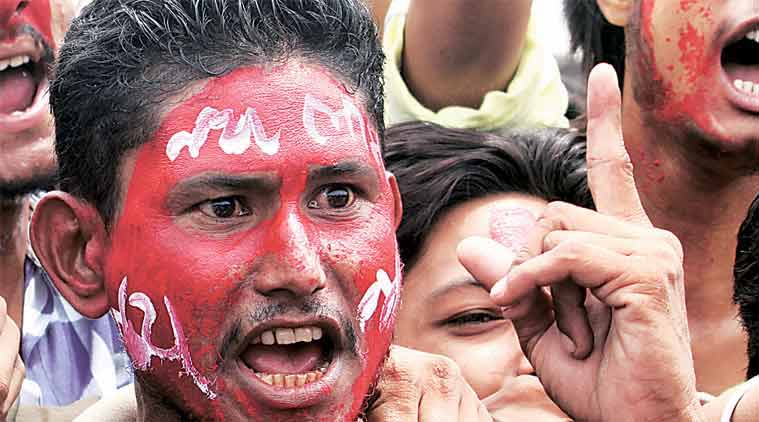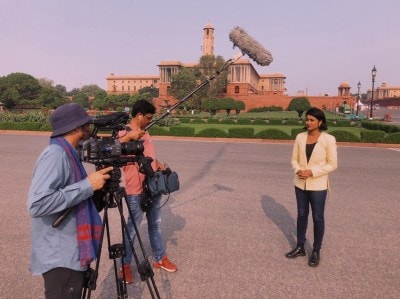- India
- International
Gau rakshak vs Make in India
Contradiction between a modern, globalised industry and the degraded position of those supplying its raw material was highlighted at Una.
 There have also been reports of the Centre planning special incentives for this highly labour-intensive and leading export-earning sector, on the lines of what has recently been announced for the textile industry.
There have also been reports of the Centre planning special incentives for this highly labour-intensive and leading export-earning sector, on the lines of what has recently been announced for the textile industry.
Consider the irony. India exported leather and leather products worth $5.9 billion in 2015-16, and $6.5 billion the previous fiscal. That’s worth almost Rs 40,000 crore a year, which also explains why leather has been identified as a sector worthy of promotion by the current government under its Make in India programme. “The total production of the Indian leather industry stands at over USD 12 billion with great potential for exports and a huge domestic market,” to quote from its website. There have also been reports of the Centre planning special incentives for this highly labour-intensive and leading export-earning sector, on the lines of what has recently been announced for the textile industry. Interestingly, these reports came in July, the same month that witnessed the flogging of four Dalit youths by self-styled gau rakshaks in Una . Their crime: Skinning a dead cow.
Carcass collection and flaying the skin off the body of dead cattle and buffaloes constitutes the first stage in the production chain of an industry that, on the face of it, has made significant progress, with India graduating from a mere exporter of raw hides and skins to that of semi-finished and finished leather since the 1970s and of leather product exports from the 1980s onwards. Well over two-thirds of exports from the sector today comprise footwear, leather goods and garments, with finished leather having a share of just about a fifth. That points to a fairly successful transition to value-added exports.
What the Una incident highlighted is the contradiction between an apparently modern and highly globalised industry on the one hand, and the degraded position of those supplying its key raw material, on the other. The Make in India website cites India’s “strong” raw materials base for the leather industry, deriving from it being home to some 191 million cattle and 109 million buffaloes, making up 21 per cent of the world’s total bovine population. But several documents — reports from official committees or industry and government bodies — have also pointed to the poor and uncertain availability of hides and skins as one of the binding constraints for the sector.
One reason for this is that carcass collection and flaying is highly dispersed across rural areas, as opposed to tanning and product-making which is largely carried out in urban industrial clusters. The lowly social status and working conditions of those engaged in skinning make matters worse. The four youths in Una who were stripped, beaten and even video-graphed in public view belonged to Gujarat’s traditional cattle-flaying Rohit community, a sub-caste within Dalits.
Usually, when a cow or buffalo dies, the farmer-owner ties a rope around the animal and drags it to the edge of the village. He then informs the flayer who takes the carcass outside village limits for stripping the skin off. The recovered hide is either cured and tanned by the flayers themselves or sold to a tanner. In many cases, the farmers simply let the animals wander away when they are no longer economical to maintain, leaving them to die and be found by the flayer.

Traditionally, flaying of dead animals was an integrated part of the rural leather industry. The flayer was often also a tanner and cobbler. That has changed over the past many decades. Very little leather product-making or tanning is now done in rural areas. But carcass collection and flaying are still linked to caste and customary obligations.
Carcass recovery can take place from slaughtered as well as fallen animals. In a country where cattle slaughter is not permitted in large parts, the latter is obviously the more common route. But even here, dead livestock are often not recovered for days, sometimes weeks, leading to recovery rates much lower than their potential. Bodies such as the Central Leather Research Institute in Chennai have estimated the net offtake rates in India — the proportion of cattle carcasses found and flayed in time for hides to retain the qualities be converted to leather — to be well below 15 per cent. That, needless to say, has no less to do with the poor economic conditions of the people entrusted by tradition with the job of carcass recovery. Even after recovery, the process by which the carcass gets flayed and converted into hide through salting and curing, is characterised by the use of crude tools and techniques. All this affects the quality of the raw material available to the hide dealer who, in turn, transports it to tanneries. It is the lakhs of people involved in carcass recovery and flaying who account for a major chunk of the “comparative advantage in cost of production and labour costs” that the Make in India campaign proudly advertised. Ironically, caste-determined practices are what keep labour costs low, while resulting in the raw material supply bottleneck.
Linked to this is yet another paradox. While alive, the cow is bestowed a ritually elevated status. But gau mata, when dead, is transformed into an object of disgust by higher castes. The Una case is not just about the caste-determined practices that govern the transition from live cow to raw hide. In attacking the people involved in the recovery and flaying of cows, it could be the harbinger of a potential crisis in an industry, involving the long chain of cow rearing, raw hide production, finished leather production, leather products production and export. The uprising by Gujarat’s Dalits after Una — invoking slogans like “You love your mother, keep her” and “You keep the cow’s tail, give us land” — represent a major challenge to an order that sees no contradiction between the practices resulting in a low recovery rates of raw hides and Make In India.
EXPRESS OPINION
More Explained
Apr 23: Latest News
- 01
- 02
- 03
- 04
- 05









































